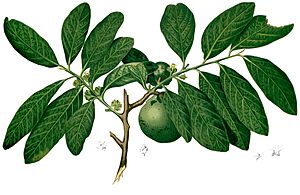Black sapote facts for kids
Quick facts for kids Black sapote |
|
|---|---|
 |
|
| Conservation status | |
| Scientific classification | |
| Genus: |
Diospyros
|
| Species: |
nigra
|
| Synonyms | |
Diospyros nigra, also known as the black sapote, is a type of persimmon fruit. People often call it the chocolate pudding fruit because of its taste and texture. In Spanish, it's known as zapote prieto.
This tropical fruit tree grows naturally in Mexico, Central America, and Colombia. The word "sapote" is a general term for any soft, edible fruit. The black sapote is not related to fruits like white sapote or mamey sapote.
Contents
About the Black Sapote Tree
Black sapote trees can grow very tall, sometimes over 25 meters (about 82 feet). They are evergreen, meaning their leaves stay green all year round. These trees don't like heavy frost, but they can handle a little bit of cold.
The leaves are long and oval-shaped, dark green, and shiny. They can be between 10 to 30 centimeters (4 to 12 inches) long. Some trees only have male flowers. Other trees have both male and female flowers.
It takes about 3 to 4 years for a tree to start producing fruit from a seed. Once they start, they usually produce a lot of fruit!
The Amazing Fruit
Black sapote fruit looks a bit like a tomato. It's usually 5 to 10 centimeters (2 to 4 inches) wide. When the fruit is unripe, its skin is olive green. As it ripens, the skin turns a deep yellow-green.
The inside of an unripe fruit is white and not good to eat. But when it's ripe, the pulp turns dark brown or black. It tastes and feels a lot like chocolate pudding! The texture is also sometimes compared to a papaya.
Most black sapote fruits have seeds, up to 12 of them. However, some types of black sapote have very few or no seeds at all. Unripe fruits are bitter and can irritate your mouth, so it's important to only eat them when they are fully ripe.
How Black Sapote Trees Grow
Black sapote trees are usually grown from their seeds. The seeds can stay good for several months before planting. It takes about 30 days for a seed to sprout and start growing.
Some black sapote trees don't have seeds. For these trees, people use special methods to grow new ones. These methods include air-layering (making roots grow on a branch while it's still on the tree) or shield budding (attaching a bud from one tree to another).
Growing Black Sapote
Black sapote trees usually grow in areas below 600 meters (about 2,000 feet) in height. They are not very picky about the type of soil they grow in. They can handle light frosts, but they don't like dry weather. If it's dry, they need to be watered regularly. They can handle a lot of water, even some flooding.
For the first 3 to 4 years, the tree grows slowly, maybe only about 30 centimeters (1 foot) a year. After that, it starts to grow much faster. When planting, it's best to space the trees about 10 to 12 meters (33 to 39 feet) apart.
Different Types of Black Sapote
There are many different types, or "cultivars," of black sapote. They can vary in tree size, how hairy their leaves are, and the size, shape, and sweetness of their fruit. Some types have more seeds than others, and they can ripen at different times.
Scientists and farmers have chosen the best types and grown them in places like the Philippines, Australia, and Florida, USA. Some special types even grow without seeds, like the 'Cuevas' cultivar.
Australian Types
- Bernicker (also 'Bernecker') is a type that produces many round, medium to large fruits. These fruits have few seeds and are known for their great quality.
- Mossman grows very large, round fruits. They have a good flavor, lots of pulp, and few seeds. One 'Mossman' tree can produce up to 450 kg (nearly 1,000 pounds) of fruit!
- Maher has very large, flat fruits that are good to excellent in quality and have few seeds. This type is special because it's a small tree (up to 4 meters or 13 feet tall) but still produces a lot of fruit.
- Ricks Late comes from New South Wales, Australia. It produces a lot of high-quality fruit later in the season.
- Superb is a type from North Queensland. It grows many small, excellent quality fruits. If it's not cross-pollinated, its fruits might not have any seeds at all!
- Cocktail is known for its excellent flavor.
Florida Types
- Mérida (also 'Reineke' or 'Reinecke') is named after where its original seed came from. It produces over 70 kg (about 150 pounds) of very sweet, small to medium-sized fruits. These fruits are very good quality and have 5-10 seeds. They also ripen earlier than other types, usually in November in Florida.
Philippine Types
- Manilla and Valesca are types that have only a few seeds.
See also
 In Spanish: Zapote negro para niños
In Spanish: Zapote negro para niños
Images for kids











